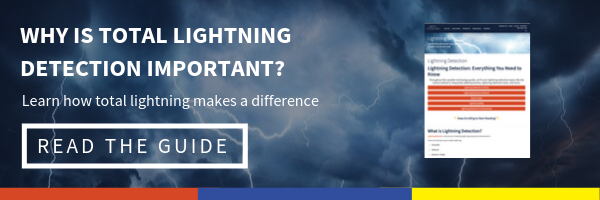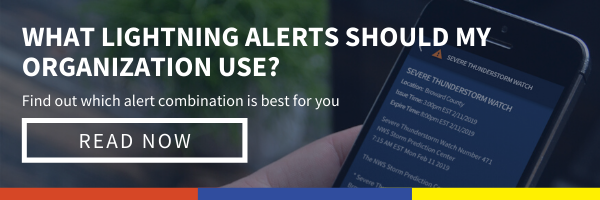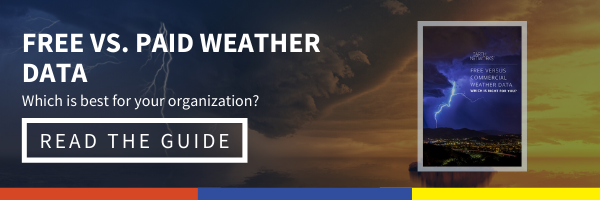How Mobile Weather Alerts Can Protect Your Business
- Dec 02, 2019
Emergency mobile weather alerts for business can make a huge impact at your organization. Here’s how:

There are dozens of threats out there that can negatively affect your business operations. That’s why it’s always a good idea to regularly sit down and list all threats you might think of. While cybersecurity threats get a lot of the focus, they aren’t the only high-impact event that can harm your organization.
Severe weather has always been a high-probability, high-impact threat for every organization that’s ever opened its doors. Unfortunately, the time we’ve spent planning for and adapting to severe weather events hasn’t minimized their occurrence. In fact, severe weather events like hurricanes, droughts, and thunderstorms cost the United States billions of dollars each year.
You can’t stop the weather from impacting your operating location(s), but you can start preparing for it with the best tools around. Mobile weather alerts for business is one of the best preparation strategies for mitigating weather risks throughout the year.
Keep reading to find out how using the right mobile weather alerts can protect your business and how to implement a severe weather safety plan.
What Are Mobile Weather Alerts for Business?
 Before we go through the ways mobile weather alerts can protect organizations from threats like lightning, hurricanes, and tornadoes, it’s important to understand what mobile weather alerts are and which ones to trust.
Before we go through the ways mobile weather alerts can protect organizations from threats like lightning, hurricanes, and tornadoes, it’s important to understand what mobile weather alerts are and which ones to trust.
You probably have a free weather application on your phone already. For most people, this is an app they check regularly to understand the basics like:
- Temperature
- Chance of Precipitation
- Weekly Forecast
While these measures can be helpful when planning what activities to do or what clothing to wear, they aren’t the most effective when planning and executing operational and safety efficiency measures during severe weather events.
That’s why more and more organizations are turning towards reliable, actionable weather data from commercial-grade weather applications.
Not only do we recommend looking at the clear advantages paid weather mobile alerts offer (like real-time updates and total lightning detection) but we also look at the alerting method.
Little things make a big difference, so it’s important that your key stakeholders receive alerts in ways that are best for them.
Some stakeholders will respond better to email alerts than text alerts. Others will react fastest when a weather application sends them a warning. It’s always important to make sure that end users cannot opt-out of these alerts.
Now that we’ve got those little notes about the right mobile weather alerts for business out of the way, let’s look at the top three ways they can protect your operations!
Three Ways Mobile Weather Alerts Can Protect Your Business

Here are the three main ways mobile weather alerts for business work to improve your organization’s preparation and response to severe weather events.
1. Increase Situational Awareness
The first way mobile weather alerts can protect your business is by increasing situational awareness.
When a thunderstorm (for example) closes in on your operating location(s), all of your employees need to know what’s going on. This includes details like the storm’s estimated time of arrival, hazards associated with the storm, and how long it might last. It doesn’t matter if you’re operating an outdoor recreational field or just an indoor manufacturing plant. These things matter to everyone.
You should set up mobile weather alerts that deliver before a dangerous weather event arrives. That way, everyone knows of the potential danger.
We typically set up mobile weather alerts based on lightning proximity. This helps organizations definite protocol for when severe weather is at different distances from their location(s). Once the lightning enters a nearer threshold, it requires different actions from staff.
For example, if mobile weather alerts activate to say that lightning is 20 miles away, employees might just monitor the situation. However, if the lightning enters a 10-mile radius, employees might take more actionable steps like evacuating outdoor areas or ceasing flammable material manufacturing.
2. Standardize Safety Protocol
The second way mobile weather alerts can protect your business is by standardizing safety protocol.
Remember when we mentioned those free weather applications that everyone has on their phones? Have you ever noticed that these weather applications don’t always say the same thing?
That’s because different weather applications get their data from different weather sources and networks. When members of your organization use data and mobile alerts form applications with different sources, they can get into arguments. These applications are a slippery slope, as arguments can lead to confusion, and confusion can lead to inaction.
When severe weather threatens your organization, a swift response is the first step to safety. By using commercial-grade mobile weather alerts and applications, you create a centralized weather hub for your organization. When everyone receives the same alerts from the same source at the same time, it makes it much easier to follow established severe weather protocol.
There are plenty of other differences between free and paid weather data. You can explore all of them in our free and information ebook.
3. Provide Proof
The last main way we think that mobile weather alerts can safeguard your organization is by providing proof.
We see a lot of organizations use human-based alerting methods for severe weather. An example of this would be an Athletic Director radio-ing coaches that severe weather is a threat or a golf course manager physically pulling golfers off the course.
Not only do human-based alerting methods take up precious time and possibly leave employees and guests in the dark, but they don’t provide proof. There will always be stubborn stakeholders who “just want to get another hole in,” or “just want to get another shipment out.”

When you use mobile weather alerts, you can show them exactly what you’re acting on. Especially if those mobile weather alerts coincide with a commercial-grade weather application. A lot of robust weather applications come with real-time weather maps. That way you can show them exactly what’s headed your way and why you took action. Providing proof makes people more likely to follow safety protocol and protects you in case they don’t.
The Best Mobile Weather Alerts for Business
Mobile weather alerts are perfect for reaching all your key stakeholders no matter where they are. This allows organizations to increase situational awareness, standardize safety protocol, and provide proof.
Together, these three benefits help you accomplish some of your most important organizational goals, like keeping people safe and optimizing operations and finances.
If you want the best mobile weather alerts to protect your organization, you need commercial-grade weather alert that also have these three, advanced features:
- Role-Based Alert Configuration
- Real-Time, Hyperlocal Updates
- Easy Setup & Implementation
Any Questions?
Have any questions about mobile weather alert options or how to implement a facility emergency notification system? Let us know in the comments below and one of our weather experts will get back to you ASAP. Stay safe out there!








